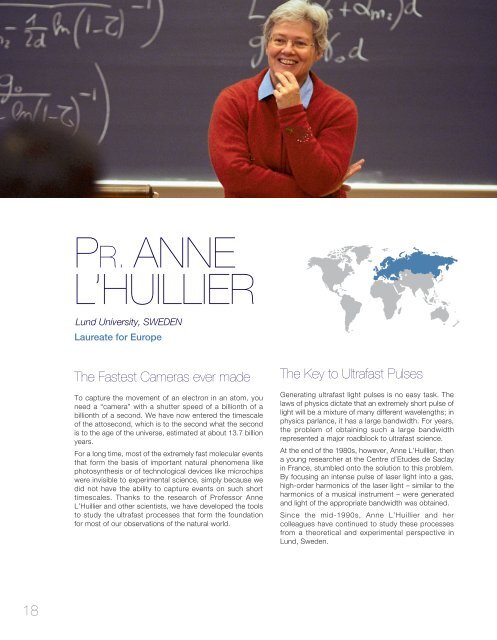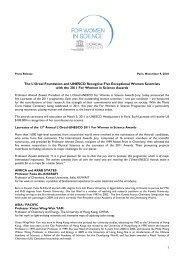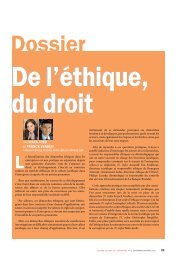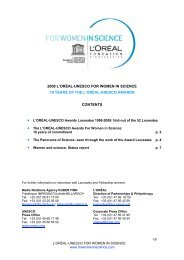2011 EDITION
2011 EDITION
2011 EDITION
You also want an ePaper? Increase the reach of your titles
YUMPU automatically turns print PDFs into web optimized ePapers that Google loves.
18<br />
PR. ANNE<br />
L’HUILLIER<br />
Lund University, SWEDEN<br />
Laureate for Europe<br />
The Fastest Cameras ever made<br />
To capture the movement of an electron in an atom, you<br />
need a “camera” with a shutter speed of a billionth of a<br />
billionth of a second. We have now entered the timescale<br />
of the attosecond, which is to the second what the second<br />
is to the age of the universe, estimated at about 13.7 billion<br />
years.<br />
For a long time, most of the extremely fast molecular events<br />
that form the basis of important natural phenomena like<br />
photosynthesis or of technological devices like microchips<br />
were invisible to experimental science, simply because we<br />
did not have the ability to capture events on such short<br />
timescales. Thanks to the research of Professor Anne<br />
L’Huillier and other scientists, we have developed the tools<br />
to study the ultrafast processes that form the foundation<br />
for most of our observations of the natural world.<br />
The Key to Ultrafast Pulses<br />
generating ultrafast light pulses is no easy task. The<br />
laws of physics dictate that an extremely short pulse of<br />
light will be a mixture of many different wavelengths; in<br />
physics parlance, it has a large bandwidth. For years,<br />
the problem of obtaining such a large bandwidth<br />
represented a major roadblock to ultrafast science.<br />
At the end of the 1980s, however, Anne L’Huillier, then<br />
a young researcher at the Centre d’Etudes de Saclay<br />
in France, stumbled onto the solution to this problem.<br />
By focusing an intense pulse of laser light into a gas,<br />
high-order harmonics of the laser light – similar to the<br />
harmonics of a musical instrument – were generated<br />
and light of the appropriate bandwidth was obtained.<br />
Since the mid-1990s, Anne L’Huillier and her<br />
colleagues have continued to study these processes<br />
from a theoretical and experimental perspective in<br />
Lund, Sweden.
















